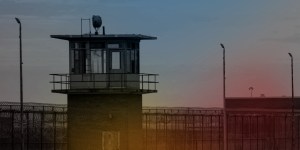Several county jails along Florida’s coast within the path of Hurricane Milton are choosing not to evacuate hundreds of incarcerated individuals as the storm makes landfall on Wednesday.
Milton, which threatens to be among the most destructive storms in a century, is expected to bring storm surges as high as 15 feet and winds of 160 mph. Tampa Mayor Jane Castor likened a single-story house in the face of the storm to “a coffin.” President Joe Biden urged residents to leave, calling the evacuation “a matter of life and death.”
Even so, at least three county jails in Florida that sit within mandatory evacuation areas have decided that detainees will ride out the storm. These jails — Pinellas, Manatee, and St. Johns counties — have a combined incarcerated population of more than 4,000 people. Recent analysis from The Appeal found that more than 21,000 people are locked up at facilities in areas with evacuation orders ahead of Milton. An earlier investigation by The Intercept found that across Florida, 52 jails, prisons and detention centers face major to extreme flood risks over the next 30 years as such climate-driven storms intensify, the most among any state.
Florida has among the largest populations of incarcerated people in the country, more than 84,000, according to federal data — exceeding the jailed populations of entire countries, such as France, Germany, Malaysia, or Venezuela.
“With that number of inmates it’s not really possible, feasible to evacuate people out of there, and it’s unnecessary because we can go up,” said Pinellas County Sheriff Bob Gualtieri on Wednesday during a press conference. He said the Pinellas County Jail, which has a population of about 3,100 people, is prepared to move people from the first floor cells to the second floor in the event of flooding.
“We have plenty of staff there, everything’s safe, it’s under control and I’m not concerned about it,” he said, adding that around 800 deputies and jail staff would be on hand. The jail sits within an area deemed Zone A, the most severe tier among evacuation areas, and is located next to a waterway that spills into Tampa Bay.
Former FEMA head Craig Fugate told The Intercept it’s typical for prisons and jails to opt not to evacuate their facilities “unless absolutely necessary.” He said evacuation orders are meant for the public, adding that jails and prisons are often built to handle the force of hurricanes.
“Evacuation of a correctional facility is a complex operation involving significant security, logistics, and staffing concerns,” said Fugate, who also directed Florida’s emergency management in 2004 when four major hurricanes made landfall in the state. “For many facilities, especially those constructed to withstand hurricanes, sheltering in place with additional preparations is the standard response.”
Also within Zone A is Manatee County Jail, which decided it will not evacuate its population of about 1,200 people. The jail sits just south of Tampa. During last month’s Hurricane Helene, neither Manatee nor Pinellas evacuated their jails, though Milton is expected to bring more severe weather.
“We’re hunkering down at the moment,” said Manatee County Sheriff’s Deputy Brandon Harvey. “You have those concerns as unpredictable as Mother Nature is, but we’re confident with what we’ve got here.”
A spokesperson for the Manatee County Sheriff’s Department said the facility is “hurricane-rated” and built on higher ground. The jail moved people with physical disabilities to the second floor ahead of the storm and is stocked with enough food and water for several days, the spokesperson said.
“If it appears water will reach the ground floor, all inmates and staff will move upstairs,” the spokesperson said. “It’s designed to accommodate full population on the upper level in that scenario.”
Harvey said the jail had been inundated with calls from concerned relatives whose loved ones are incarcerated, asking for an early release. An American Civil Liberties Union petition from 2022 estimated around 400 people were held at the jail due to inability to pay bond.
On Florida’s east coast, St. Johns County Jail also does not plan to evacuate, despite an evacuation order issued for the entire county of more than 300,000 people.
Some jails, however, were less confident in the resiliency of their facilities. Officials at Orient Road Jail, the largest in Tampa, transported their incarcerated population to Falkenburg Road Jail, which is not within a mandatory evacuation zone, said a spokesperson for the Hillsborough County Sheriff’s Office.
On the state prison level, officials said they relocated 5,640 incarcerated people into facilities built to withstand storms.
Denise Rock, executive director of prisoner advocacy nonprofit Florida Cares, said she was pleased with the state’s response to protect its incarcerated population ahead of Milton and during Helene.
“But they have not been in past years,” she said.
Amid flooding in 2014 in northwest Florida, a basement at Escambia County Jail had flooded, causing dryers to float and disconnect from their natural gas lines, causing an explosion that killed two people and injured 184 others.
Hurricane Michael in 2018 tore through the roof of Gulf Correctional Institution Annex, a Florida state prison, exposing nearly 3,000 people incarcerated there to the elements. No injuries were reported at the prison. Rock noted other facilities lacked food and water during that storm.
Several years later, in 2022, Hurricane Ian had damaged and flooded one county jail near Fort Myers, while inmates at a nearby jail reported unsanitary living conditions and a lack of water rations.
The Manatee jail had also faced criticism in the past for not evacuating people incarcerated there when threatened by disaster. In 2021, toxic waste leaking from a nearby reservoir threatened to flood the jail. Officials evacuated around 200 people, but three-quarters of the jail population remained, drawing ire from advocates, according to Southerly Magazine.
Elsewhere, during Hurricane Helene, people incarcerated at a state prison in North Carolina were forced to sit in their cells for days with no light or running water, at times sleeping amid bags of their own feces.
Rock said she remained concerned about the lack of communication between the state prison and the families of incarcerated people. She also worried that even if prisons were hardened to withstand winds, intense rain could lead to untenable living conditions inside.
“Flooding is definitely a problem, ’cause many of these windows don’t close or have any screens or any protection from the elements,” she said, noting the small size of cells and cramped living conditions if inmates are forced to integrate with other facilities amid relocations. She said it’s common for some people to sleep on the floor throughout the storm due to lack of beds.
As of Wednesday afternoon, tropical storms and tornados began to rage along Florida’s coast. Milton was expected to make landfall by Wednesday night.





